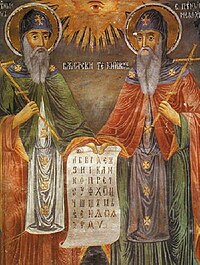Kîrîl û Metodiyos
Kîrîl û Metodiyos, (bi yewnanî: Κύριλλος καὶ Μεθόδιος, Kírillos kai Methódios) du birayên yewnaniyên bîzansî bûn ku di sedsala 9an de li Selanîkê hatibûne dinê.[1][2] Bi mebesta xiristiyankirina gelên slav ên Bulgaristan, Moravyaya Gewre û Panonya hatibûne wezîfedarkirin. Weke mîsyonerên slavan tên nasîn. Tê bawerkirin ku va birayan alfabeya Glagolîtîk çêkiriye.[3][4]
Kîrîl û Metodiyos | |
|---|---|
 | |
| Pêk tê ji | |
| biguhêre - Wîkîdaneyê biguhêre | |

Li ser gelên slav bandora we gelek xurt bû lewma piştî mirina wan jî şagirtên wan misyona wan berdewam kirin. Her du bira jî ji aliyê Dêra Ortodoks ve bi ezîztiyê hatin pîrozkirin. Di 1880'yî de papa Leo XIII ji bo van birayan di salnameya Katolîkî de şahî da destpêkirin. Herwiha di 1980'yî de papa Yûhana Paulê II bi Benedîktê Nursiyayî re ev her du bira weke ezîzên sereke yên Ewropayê pejirand.[5]
Çavkanî biguhêre
- ^ Columbia Encyclopedia, Sixth Edition. 2001–05, s.v. "Cyril and Methodius, Saints"; Encyclopædia Britannica, Encyclopædia Britannica Incorporated, Warren E. Preece – 1972, p.846, s.v., "Cyril and Methodius, Saints" and "Eastern Orthodoxy, Missions ancient and modern"; Encyclopedia of World Cultures, David H. Levinson, 1991, p.239, s.v., "Social Science"; Eric M. Meyers, The Oxford Encyclopedia of Archaeology in the Near East, p.151, 1997; Lunt, Slavic Review, June, 1964, p. 216; Roman Jakobson, Crucial problems of Cyrillo-Methodian Studies; Leonid Ivan Strakhovsky, A Handbook of Slavic Studies, p.98; V.Bogdanovich, History of the ancient Serbian literature, Belgrade, 1980, p.119
- ^ The Columbia Encyclopaedia, Sixth Edition. 2001–05, O.Ed. Saints Cyril and Methodius "Cyril and Methodius, Saints, 869 and 884, respectively, "Greek missionaries, brothers, called Apostles to the Slavs and fathers of Slavonic literature."
- ^ Alan Timberlake, A Reference Grammar of Russian, Cambridge University Press, 2004, p 14: "In order to write in Slavic they devised a new alphabet which is now called Glagolitic."
- ^ Florin Curta & Paul Stephenson, Southeastern Europe in the Middle Ages, 500-1250, Cambridge University Press, 2006, p 214: "At the emperor’s request, Constantine and his brother started the translation of religious texts into Old Church Slavonic, a literary language most likely based on the Macedonian dialect allegedly used in the hinterland of their home-town, Thessalonica. Constantine devised a new alphabet, later called Glagolitic, to render the sounds of the new language and to adapt it to the new conditions iii Moravia. The two brothers seem to have initially translated only texts for religious instruction, such as the excerpts from the Gospels that were used in liturgy."
- ^ http://www.vatican.va/holy_father/john_paul_ii/apost_letters/documents/hf_jp-ii_apl_31121980_egregiae-virtutis_lt.html 31 December 1980